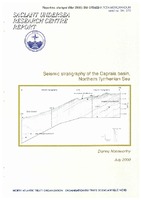Seismic stratigraphy of the Capraia basin, Northern Tyrrhenian Sea

Abstract
The distribution and thickness of sediments within the Capraia Basin, Northern Tyrrhenian Sea, have been mapped using high-resolution seismic reflection data. The data were studied within the geologic framework determined by previous works conducted in the Northern Tyrrhenian Sea. This study was especially influenced by the work of Brizzolari et al (1991). Collectively these studies show that sediment above the basement in the Capraia Basin consists of at least two seismic units, deposited since the Mid-Upper Pleistocene. Unit 1 is correlated with Brizzolari's et al., (1991) unit B, and unit 2 with his unit C. Unit 1 lies unconformably below unit 2, and covers a vast area within the Capraia Basin. As determined by Brizzolari et al., (1991), the deposition of unit B and unit 1 was strongly influenced by Mid-Upper Pleistocene glacio-eustatic fluctuation. Subsequent rise and fall of sea level within shallower regions of the basin, especially between 115-100 m water depth, resulted in the deposition of stacked sedimentary successions (of unit 2) which display strong erosional character and discontinuity. Basinward, unit 1 thickens drastically, from 10 - 80 ms twtt, into a package of aggregated to slightly progradational reflectors. Conversely, unit 2 thins basinward. It is limited geographically to the northwestern region of the Capraia Basin. As determined by Brizzolari et al., (1991), the geometry of unit 2, is strongly influenced the depositional setting. Unit 2 is composed of a thin (1- 15 ms twtt) package of stratified reflectors, which taper westward. Studies have shown that successions correlating with unit 2 are predominantly composed of sediment transported into the basin by modern day feeding sources, with dominant influence coming from the Cecina River, located northeast of the study area. Brizzolari et al., (1991) interpreted unit 2 to be the result of present-day highstand sedimentation in the Capraia Basin, deposited since the Holocene.
Report Number
SM-370Date
2001/01Author(s)
Noseworthy, Dianne